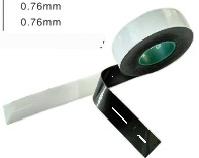Industrial Marking Tape Essential Tool in Modern Workspaces
In today's fast-paced industrial environment, safety, efficiency, and organization are paramount. One of the simplest yet most effective tools to promote these principles is industrial marking tape. This specialized tape is designed to create effective visual communication markers in factories, warehouses, construction sites, and other industrial settings. From marking hazardous areas to identifying pathways and equipment, industrial marking tape plays a critical role in enhancing safety and operational flow.
Types of Industrial Marking Tape
Industrial marking tape comes in various types, each serving distinct purposes. The most common types include floor tape, safety tape, and colored marking tape.
1. Floor Tape This type of tape is often used in warehouses and production facilities to delineate walking paths, storage areas, and work zones. Available in bright colors, floor tape stands out on concrete and other surfaces. It provides clear visual cues that help workers navigate safely while minimizing the risk of accidents.
2. Safety Tape Safety marking tape is essential for designating hazardous areas, such as spots where heavy machinery operates or where chemicals are stored. Often featuring yellow and black or red and white striped patterns, safety tape alerts employees to potential dangers, thereby reducing the likelihood of accidents.
3. Colored Marking Tape Colors play a significant role in visual communication. Different colors can indicate various functions or signify specific restrictions. For example, green tape may indicate safety equipment locations, while blue might mark areas that are ‘clean’ or out of service. The use of color coding enhances the understanding of site regulations and operational protocols.
Benefits of Using Industrial Marking Tape
industrial marking tape

The advantages of incorporating industrial marking tape into a workspace are numerous. First and foremost, it improves safety. By clearly marking hazardous areas and pathways, businesses can reduce the occurrence of accidents, thereby protecting their employees and minimizing potential liability issues.
Secondly, marking tape promotes efficiency. Visual cues help guide workers through complex environments, allowing for smoother workflow and faster task completion. With designated areas for equipment, tools, and materials, employees can easily find what they need, reducing downtime caused by searching for misplaced items.
Furthermore, industrial marking tape is durable and versatile. Most types are resistant to wear and tear, capable of withstanding the rigors of industrial environments, including exposure to chemicals, heavy traffic, and varying weather conditions. This durability ensures that the markings remain visible over time, contributing to ongoing safety and organization.
Installation and Maintenance
Installing industrial marking tape is a straightforward process that requires minimal preparation. The surface should be clean and dry for optimal adhesion. Many products come in rolls and can be cut to size, making it easy to create custom patterns and layouts.
Maintenance involves periodic checks to ensure the tape remains intact and visible. If the tape shows signs of wear or damage, it can be easily replaced, allowing for continuous compliance with safety regulations and operational standards.
Conclusion
In conclusion, industrial marking tape is a vital tool for enhancing safety, efficiency, and organization in various industrial settings. With its diverse types and applications, it provides clear visual cues that guide and protect workers while streamlining operations. As industries continue to evolve and prioritize safety, the use of industrial marking tape will undoubtedly remain a critical component of effective workplace management. Whether in warehouses, factories, or construction sites, this simple yet essential tool contributes to a safer and more productive environment for all.
-
XIANGFAN Rubber Tape-Ultimate Solutions for All Your Insulation NeedsNewsJun.24,2025
-
XIANGFAN Rubber Tape-Protection for Industrial and Residential ApplicationsNewsJun.24,2025
-
XIANGFAN Rubber Tape: Superior Safety and Sealing for Demanding EnvironmentsNewsJun.24,2025
-
XIANGFAN Rubber Tape: Reliable Solutions for Every Electrical ChallengeNewsJun.24,2025
-
XIANGFAN Electrical & Industrial Tape: Powering Reliability Across IndustriesNewsJun.24,2025
-
XIANGFAN Electrical & Industrial Tape: Excellence in Every ApplicationNewsJun.24,2025
